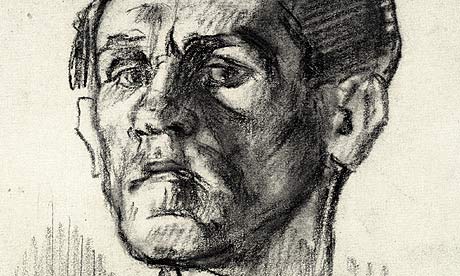 |
| Bruno Schulz |
A brief survey of the short story part 30:
Bruno Schulz
A writer who redraws the boundaries between fact and imagination, Schulz is a master of what he called 'the mythicisation of reality'

At once direct and arcane ... a self-portrait drawing by Bruno Schulz
The Polish Jewish writer Bruno Schulz described Sanatorium Under the Sign of the Hourglass (1937), the second of his two surviving collections of stories, as "eliciting the history of a certain family, a certain house in a provincial city – not from documents, events, a study of character or people's destinies – but by a search for the mythical sense, the essential core of that history ... These mythical elements are inherent in the region of early childhood fantasies, intuitions, fears and anticipations characteristic of the dawn of life."
Schulz's first book, The Street of Crocodiles (Cinnamon Shops in the Polish original), pursues the same aim, which he called "the mythicisation of reality". Its publication in December 1933 saw Schulz – a shy, rather awkward schoolteacher – join Stanislaw Witkiewicz and Witold Gombrowicz in the front rank of Polish modernists. Rarely does such a strange work win immediate recognition, but Schulz's writing pulls off the neat trick of being at once direct and arcane. Instantly striking for its beauty and peculiarity of vision ("sides of meat with their keyboard of ribs swollen with energy"; beds "disordered from the weight of dreams", standing "like deep boats waiting to sail into the dank and confusing labyrinths of some dark starless Venice"), its narrative paths are conversely crooked and confounding, leading the reader into neighbourhoods of paradox and uncertainty. Most of his stories involve the narrator, at once a child and a man remembering his childhood, describing the eccentric projects of his father, the merchant Jacob, whose personality cycles through biblical patriarchs (Noah, Moses, Joshua), who regularly dies and matter-of-factly returns, and who metamorphoses into a succession of beasts and insects.
This last aspect in particular draws comparisons with Kafka, and the two writers share many biographical similarities (not least a father obsession). But while both described worlds stuttering between the real and unreal, their purposes and methods are quite distinct. Neither is Schulz a surrealist: bizarre occurrences flood his fiction (people transformed into bundles of rubber tubing; a man engineered into a doorbell; Hades relocated to provincial Poland), but his project prizes rather than disdains logic, and he doesn't seek to shock.
Schulz referred to childhood and its boundless imaginings as the "age of genius", and its memories and impressions, crossbred with fragments of Greek and Hebrew myth, Polish and German folktales and quite probably Hasidic literature, became the "iron capital of the spirit" from which his art was manufactured. The "provincial city" he writes about is Drohobycz, where he spent most of his life. In 1892, when Schulz was born, it lay within the Austro-Hungarian Empire's borders. After the first world war it was Polish. By the time he died, in 1942, following a brief Soviet occupation, the town was part of the Nazis' Greater Germany. It's now Ukrainian.
Schulz, a secular Jew, was shot dead by the SS in the Drohobycz ghetto on 19 November 1942. I won't expand on the tragic and chilling nature of his murder because doing so, as the academic David A Goldfarb notes in a 1994 study, "projects a teleology backward onto the artist's work". Schulz's fantastical, elaborately interpretable stories, mostly written in the late 1920s and early 1930s, freely intermingle the past and present, but the future, as Jerzy Ficowski notes in his invaluable monograph, Regions of the Great Heresy, is "a nonexistent category" to him. His stories don't presage the Holocaust; to read them as if they do distorts both them and him.
Distortion is germane to a discussion of Schulz. Because of how he died, because much of his work – including the tantalisingly rumoured novel, The Messiah – is lost, and because of his talent, he has proved magnetic to other authors, whose work by turns uncovers and occludes his own. Isaac Bashevis Singer, John Updike and JM Coetzee have critiqued him; he features in novels by Philip Roth, Cynthia Ozick and David Grossman; Salman Rushdie's The Moor's Last Sigh recreates the Street of Crocodiles in Andalucia; Jonathan Safran Foer has recently released Tree of Codes, a story die-cut from The Street of Crocodiles. More has been written about him than he ever wrote himself.
It's fitting that Schulz, who believed so much in the living, interpolating qualities of texts, should cross-pollinate like this. David Goldfarb writes, "There are no boundaries between books and the world for Schulz ... Following the cycle of 'the mythicisation of reality', a book becomes a reality, which becomes another book." Stepping in and out of myth, in and out of literature, in and out of the fantastical and the everyday, and using the material gathered from each region to make something new and unrepeatable, Schulz redrafts the lines between fantasy and reality following an obscure but apparently robust logic, the precise architecture of which is still being fathomed.
His fictions contain vivid precincts to explore, constructed by an artist who understood –in fact worshipped – the powerful connections that lie, waiting to be made, between the covers of a book. In a letter of 1936 Schulz wrote: "Outside it is a cold day, hard and unyielding, full of prose and harshness. But good spirits have gathered around my bed, beside me are two volumes of Rilke that I have borrowed. From time to time I enter his difficult and intense world for a moment, beneath his many-arched skies, and again I come to myself."



No comments:
Post a Comment